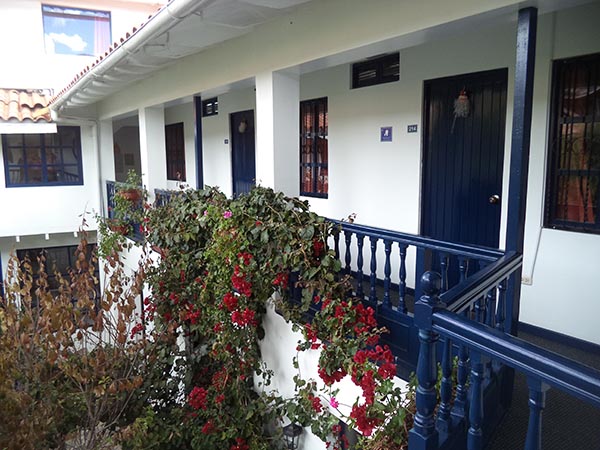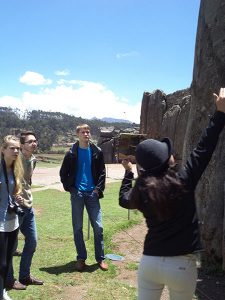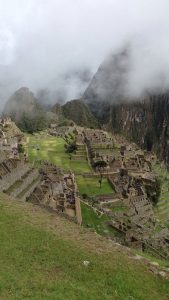Sam Brown: Student Report from 2015 Alternative Winter Break in Peru

I emailed Ms. Judith Mallory one day after class, relatively spontaneously, about the Engineering trip she was organizing for Winter Break in 2015. The idea originally came to me, spawned by the necessity to fulfill various requirements for various programs. For instance, the Chancellor’s Honors Program requires a “Ready for the World” experience, which I interpreted to mean “Study Abroad.” I was pleasantly surprised to learn that I could fulfill this requirement over Winter Break (which is too awkwardly short to assume an internship or some other constructive experience) at a fraction of the cost of a full semester abroad. Also, the trip’s destination, Peru, piqued my interest. I had traveled before, mainly in Europe, but the opportunity to experience an entirely new culture, dissimilar to both European and North American ones, was one I could not pass up.
We flew out of Knoxville the day immediately following my last final exam for the semester, and arrived in Cusco, Peru, the following morning. The minute I got off the plane I noticed the thin air of the 11,000-feet-above-sea-level-Andes, and I was hurting; my lungs and muscles are accustomed to the abundant oxygen of 800-to-900-feet-above-sea-level-Knoxville. Also, since I had unwisely used the majority of our flight enthralled with various cinematic experiences (as they were free, and I am in college), I resigned the rest of the day to sleeping soundly in a hotel bed. That night, I first experienced a Peruvian meal. It consisted of a roasted chicken (different people received different parts – I believe I consumed a wing) on an enormous bed of…French fries? Indeed, almost every meal I ate that week consisted at least in part of a healthy portion of French fries. I later discovered that 4,000 kinds of potato are native to Peru, and that the indigenous people of Peru, the Quechua, were the first to domesticate the potato – I was no longer surprised at the abundance of potato products, only intrigued.

We spent the majority of the next day touring various historical sites throughout Peru. Most of them were very well-preserved, and all of them were fascinating. Unfortunately, I forgot to apply sunscreen before this day-long adventure, and my nose singularly despised my forgetfulness throughout the rest of the week, as it was thoroughly roasted in the noon-day rays of the Cusqueñan sun. Needless to say, I made no such error afterward.
The next few days were dedicated to the main project of the trip. We built cook-stoves for various poorer families in a very rural part of the Cusco province in Peru. Many of these families already possessed structures that could perform the function of a stove, but they were inefficient, and most of them were in enclosed spaces, so the smoke emitted by the wood-burning fire billowed out into the room/s and thick
layers of ash clung to the walls. I will take this opportunity to mention that for some odd reason, the smell of a campfire will generate a slight headache deep within the confines of my skull. So the vastly amplified smoke from these stoves substantially hindered my efforts at breathing. We were tasked with building much more permanent and useful cook-stoves, with a system that would hopefully channel the smoke out a chimney. We divided up into teams of about four or five each day (there were just over twenty of us in total) and conquered. On the last day, we had completed fifteen stoves. Each day, we had opportunities to interact with the people of the village where we were working, and each day, we were humbled by new sights and experiences. One of the most memorable experiences of the entire trip for me was playing soccer (one of my favorite physical activities) with some of the Peruvian people. I like to think that I am a fairly decent player, but they were running circles around me as I lay facedown in the dirt, because I was gasping for that precious oxygen after I ran only ten feet.
Not long after our last day at the worksite – the time seemed to pass so quickly – I was saying goodbye to a large portion of our group. I had elected (along with several others) to stay in Peru an additional two days for the express purpose of visiting the famous Machu Picchu. On the same day that many of our comrades were departing Peru, we (me and two of my roommates) decided to add to our list of experiences. We went on a high-action adventure that involved an ATV tour that lasted approximately two and a half – three hours (and which toured sites we had not yet seen with the whole group on our organized tours), and the world’s longest zipline, which is roughly 1.6 miles long. That is a fairly substantial distance, but the best part was the time it took to traverse that distance, only about 90 seconds. If my engineering skills are not failing me, we were traveling at an average speed of about sixty mph…it was fun.

We got up early the next morning to catch the bus to catch the train to catch the bus to Machu Picchu. It took about four hours to arrive to our final destination, and it was definitely worth it. The views were incredible, and the structures phenomenal. The stories told by the guide were interesting, and the rivers far, far below were scintillating. The precision that the Inca (the more educated members of the Quechua society) used to accomplish outstanding architectural feats and to very accurately predict weather via astronomical knowledge was probably the most amazing thing about their whole society (at least to me), and this precision was evident throughout Machu Picchu. The only drawback was the plethora of stairs. They were everywhere and seemed to go out of their way to be in my path. So after an entire five to six hours of quadricep calisthenics, we caught the bus to catch the train to catch the bus back to our hotel. The day’s events left me nearly devoid of life, and I was asleep before I could manage to take my jacket off.
The trip back home was sad in some respects (though I was looking forward very much to the thick, luxurious air of Knoxville, as well as to milk, which seemed to be nonexistent in Peru), but I cannot say I was conscious for much of the experience.
As a whole, the trip was phenomenal, and I can’t wait until I can travel again to some other far-reaching part of the world. I think that this was an invaluable experience for me, and it left me humbled and eager to learn more about what other sensational experiences the world has to offer.